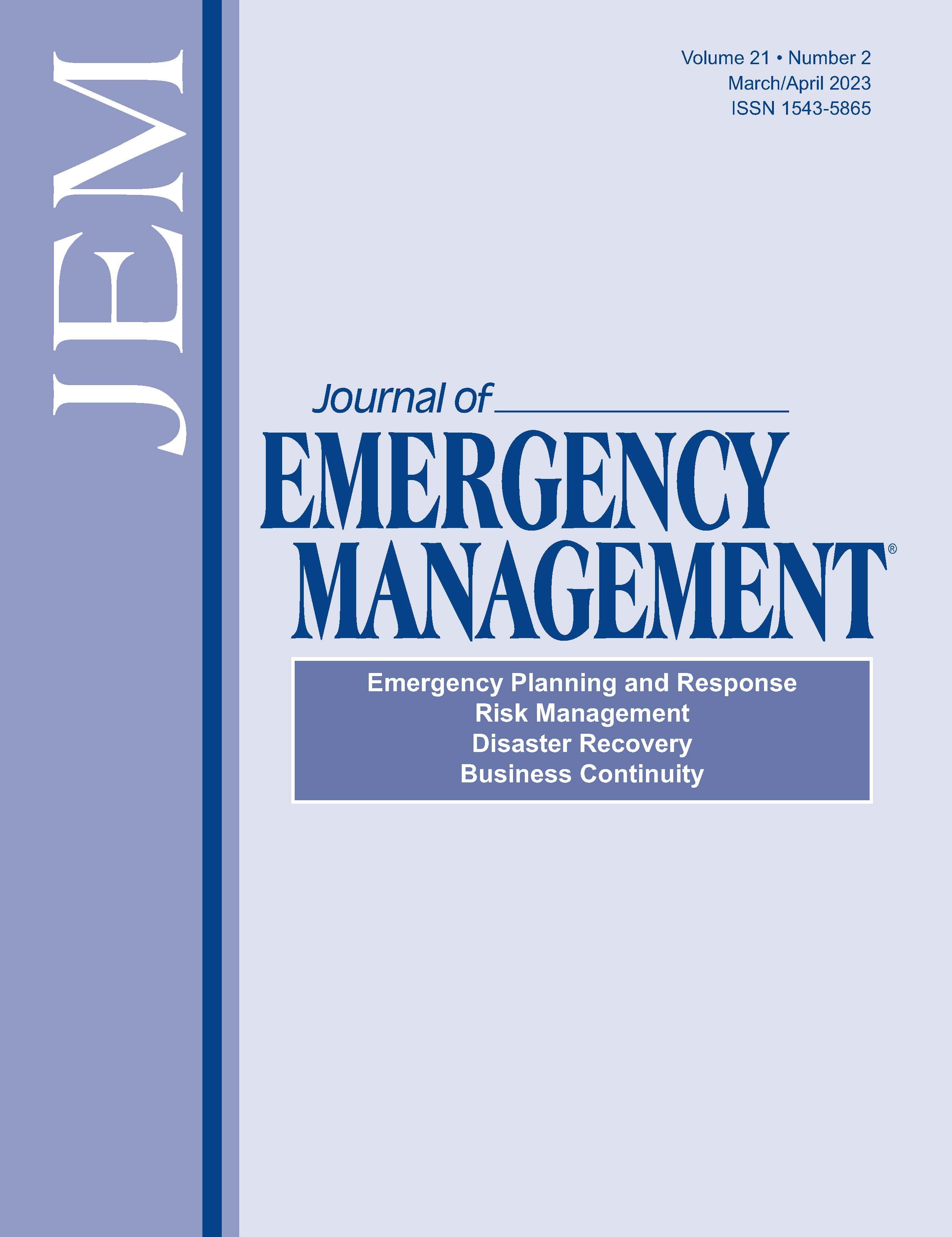Mitigation insights from emergency managers on working with stakeholders
DOI:
https://doi.org/10.5055/jem.0699Keywords:
mitigation, mitigation stakeholders, emergency management, disaster mitigation, hazard mitigationAbstract
Emergency managers have the important responsibility of planning and implementing mitigation policies and programs to reduce losses to life and property. To accomplish these goals, they must use limited time and resources to ensure the communities they serve have adequately mitigated against potential disasters. As a result, it is common to collaborate and coordinate with a wide variety of partner agencies and community organizations. While it is well established that strengthening relationships and increasing familiarity improve coordination, this article advances that narrative by providing direct insights on the ways a select group of local, state, and federal emergency managers view relationships with other mitigation stakeholders. Using insights from a 1-day workshop hosted at the University of Delaware to gather information from mitigation stakeholders, this article provides a discussion of commonalities and challenges workshop participants identified with other stakeholder groups. These insights can inform other emergency managers about potential collaborators and coordination opportunities with similar stakeholders in their own communities.
References
Convertino G, Mentis HM, Slavkovic A, et al.: Supporting common ground and awareness in emergency management planning: A design research project. ACM Trans Comput Hum Interact. 2011; 18(4): 1-34.
Feldmann-Jensen S, Jensen SJ, Maxwell Smith S, et al.: The next generation core competencies for emergency managers. J Emerg Manag. 2019; 17(1): 17-25.
Kapucu N: Collaborative emergency management: Better community organizing, better public preparedness and response. Disasters. 2008; 32(2): 239-262.
Samuel C, Siebeneck LK: Roles revealed: An examination of the adopted roles of emergency managers in hazard mitigation planning and strategy implementation. Int J Disaster Risk Reduct. 2019; 39: 101145.
Kapucu N: Developing competency-based emergency management degree programs in public affairs and administration. J Public Aff Educ. 2011; 17(4): 501-521.
Pechta LE, Brandenburg DC, Seeger MW: Understanding the dynamics of emergency communication: Propositions for a four-channel model. J Homeland Secur Emerg Manag. 2010; 7(1): 55.
Reddick CG, Rahm D: Perceptions of emergency management in US cities: A survey of chief administrative officers. J Emerg Manag. 2010; 8(6): 29-43.
Drabek TE: Community processes: Coordination. In Rodriguez H, Donner W, Trainor J (eds.): Handbook of Disaster Research. Cham, Switzerland: Springer, 2018: 521-549.
Drabek TE, McEntire DA: Emergent phenomena and multiorganizational coordination and disasters: Lessons from the research literature. Int J Mass Emerg Disasters. 2002; 20(2): 197-224.
McEntire DA, Dawson G: The intergovernmental context. In Waugh Jr WL, Tierney K (eds.): Emergency Management: Principles and Practice for Local Government. Washington, DC: International City/County Management Association, 2007: 57-70.
McAllister T: Guide for community resilience planning offers improved event response through recovery planning. IAEM Bull. 2016; 10: 33-34.
Federal Emergency Management Agency: Mitigation planning and grants. Available at https://www.fema.gov/emergency-managers/risk-management/hazard-mitigation-planning/requirements. Accessed March 15, 2022.
Federal Emergency Management Agency: Mitigation ideas: A guide for reducing risk to natural hazards. Available at https://www.fema.gov/sites/default/files/2020-06/fema-mitigationideas_02-13-2013.pdf. Accessed July 15, 2021.
Federal Emergency Management Agency: Building private-public partnerships. Available at https://www.fema.gov/sites/default/files/documents/fema_building-private-public-partnerships.pdf. Accessed March 15, 2022.
Slotter R, Trainor J, Nibbs F, et al.: NSF Leading Engineering for America’s Prosperity, Health and Infrastructure (LEAP-HI) Mitigation and Insurance Full Project Report: Stakeholder Perceptions of Mitigation and Insurance. Newark, DE: University of Delaware Disaster Research Center Final Project Report #61, 2019.
Bianchi C, Nasi G, Rivenbark WC: Implementing collaborative governance: Models, experiences, and challenges. Public Manag Rev. 2021; 23(11): 1581-1589.
Published
How to Cite
Issue
Section
License
Copyright 2007-2025, Weston Medical Publishing, LLC and Journal of Emergency Management. All Rights Reserved.






